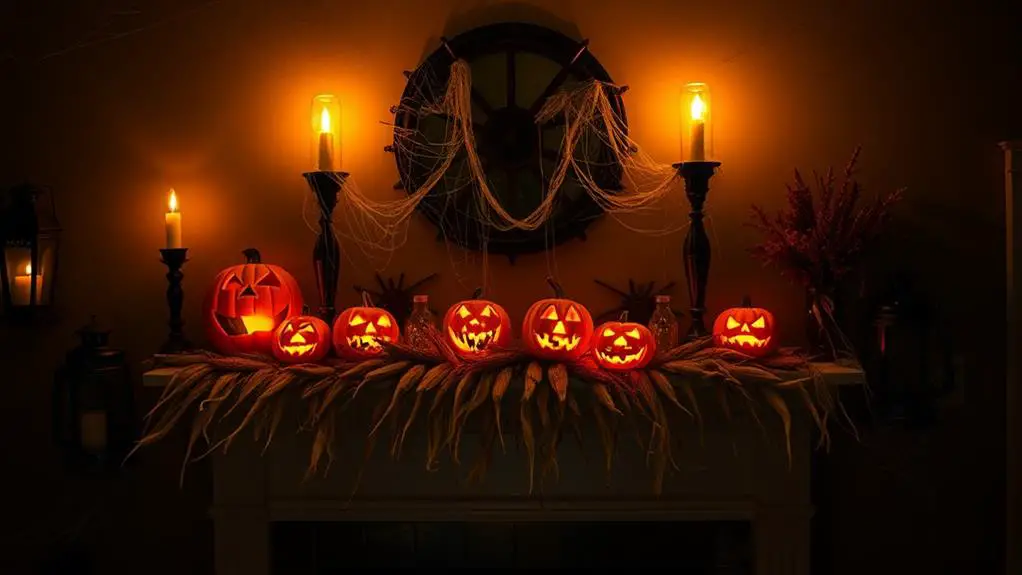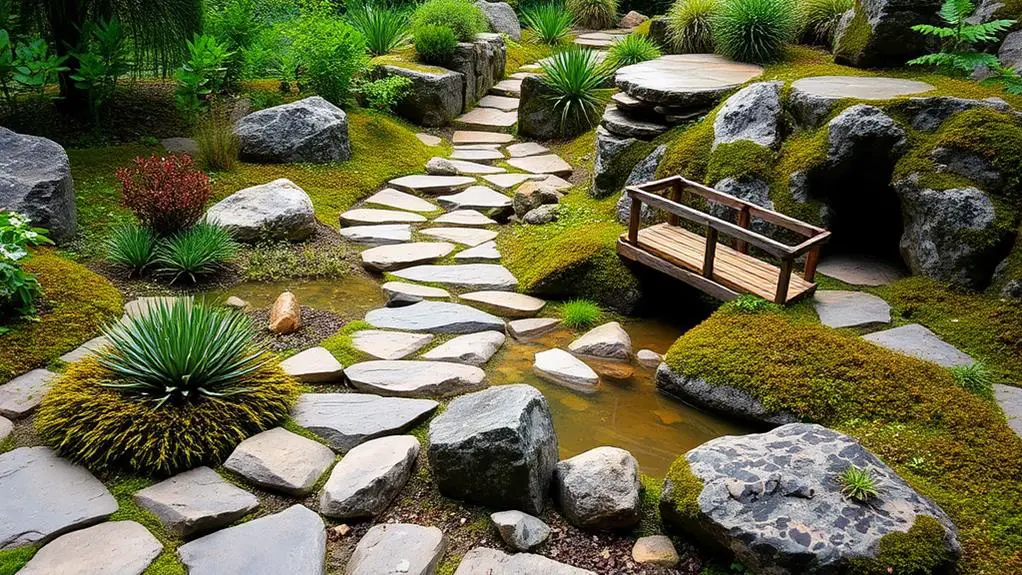As you envision your ideal front yard, consider the unique charm of a succulent rock garden. By combining these two low-maintenance elements, you can create a visually striking space that's both beautiful and easy to care for. With a wide range of succulent species to choose from, you can select a palette of colors and textures that reflect your personal style. But where do you start? What types of rocks and gravel will complement your succulents best, and how can you design a layout that draws the eye and invites exploration?
Summary
- Combine succulents with varying textures, like soft and prickly, to create visual interest in the rock garden.
- Select rocks of different sizes, shapes, and colors to add depth and contrast to the garden.
- Strategically group succulents and varied visual heights to guide the viewer's eye through the space.
- Use decorative accents, like statues or mulch, to elevate the design and create a visually appealing succulent rock garden.
- Incorporate meandering pathways and soft lighting to invite visitors to explore and discover hidden gems in the garden.
Choosing the Right Succulents
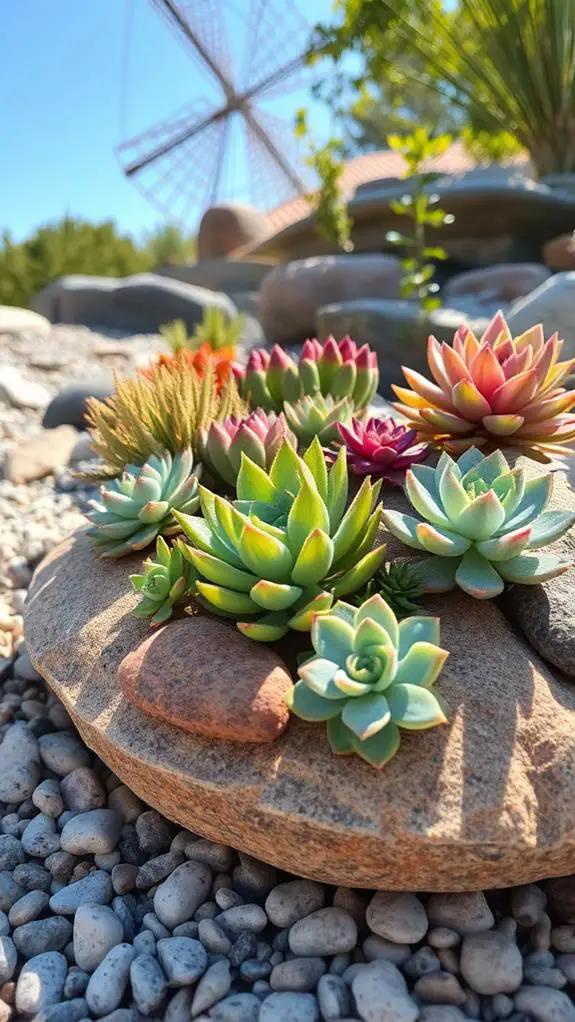
When crafting a succulent rock garden, selecting the right succulents is essential to creating a visually appealing and thriving landscape.
You'll want to choose succulent types that complement each other in respect to texture, shape, and size. Consider a mix of low-growing, spreading succulents like Sedum or Creeping Jenny alongside taller, upright varieties like Echeveria or Aloe.
Don't forget to think about succulent colors, too – a palette of blues, greens, and purples can create a soothing, monochromatic look, while a rainbow of colors can add vibrancy and energy.
Selecting Rocks and Gravel

With your diverse selection of succulents in hand, you're ready to create a visually striking backdrop with rocks and gravel.
When selecting rocks, consider varying rock sizes to add depth and visual interest to your garden. Larger rocks can serve as focal points, while smaller rocks can fill in gaps and create a sense of texture.
Gravel colors can also greatly impact the overall aesthetic of your garden. Neutral tones like beige or gray can provide a subtle contrast to your succulents, while bold colors like red or black can make a statement.
Experiment with different combinations to find the perfect balance for your unique design.
Designing a Visually Appealing Layout
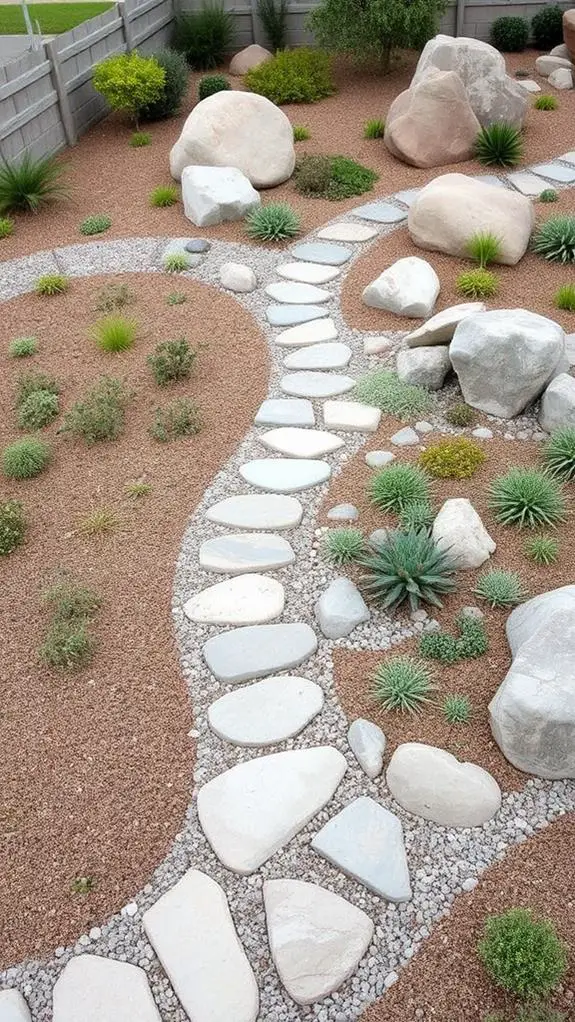
You'll create a stunning succulent rock garden by designing a layout that incorporates a thoughtfully planned rocky base.
Strategically grouped succulents, and varied visual heights will work together to guide the viewer's eye through the space.
Rocky Base Design
A well-designed rocky base is essential to creating a visually appealing succulent rock garden, as it provides a sturdy foundation for your plants to thrive on.
You'll want to create a rocky foundation that's both functional and aesthetically pleasing.
Start by arranging boulders in a way that creates visual interest. Consider a triangular formation, with smaller rocks and pebbles filling in the gaps.
This will create a sense of depth and texture. You can also incorporate different colors and textures of rocks to add visual appeal.
Make sure to leave enough space between the rocks for your succulents to spread out and grow.
Succulent Grouping Ideas
Now that your rocky base is in place, it's time to think about the arrangement of your succulents.
To create a visually appealing layout, consider creating succulent mixes by combining plants with varying textures, colors, and sizes.
Group them in clusters to add depth and visual interest. You can create a focal point by placing a statement succulent, like a large aloe or agave, in the center of the bed, and then surround it with smaller, complementary plants.
Alternatively, create a drift of smaller succulents in a single color or texture to create a cohesive look.
Remember to leave enough space between each cluster to avoid overcrowding and allow for growth. Balance and harmony will be key to a stunning succulent rock garden.
Visual Height Variety
Harmony in a succulent rock garden is often achieved through a deliberate manipulation of visual heights, which adds depth and complexity to the overall design.
As you design your layout, consider incorporating scale changes to create visual interest. You can achieve this by grouping plants of varying heights together or by using rocks of different sizes to create a sense of layering.
Strategically place focal points, like statement succulents or decorative rocks, to draw the eye to specific areas of the garden.
Creating a Succulent Rock Border

As you create a succulent rock border, you'll need to choose rocks that complement your plants and design.
Selecting the right rocks is vital, so consider factors like texture, color, and size to guarantee a harmonious blend.
Rock Selection Essentials
When crafting a succulent rock border, selecting the right rocks is essential to achieving a visually stunning display.
You'll want to choose rocks that complement the colors and textures of your succulents. Visit a rock quarry to explore different types of rocks, such as decomposed granite, river rocks, or fieldstones.
Consider the size, shape, and color of the rocks, as well as their porosity, which affects drainage. Verify the rocks are clean and free of debris to prevent soil contamination.
Proper soil preparation is also pivotal, as it affects the overall health of your succulents. Mix in organic matter like compost or perlite to improve soil structure and drainage.
Border Design Tips
Your succulent rock border's design is where your creativity shines.
You can choose from various border styles to complement your rock selection. Consider a curved border to soften the overall look or a geometric border to add visual interest.
Succulent edges can be used to create a beautiful, layered effect. For a modern look, use a clean, straight edge, or opt for a more rustic, natural edge.
To add texture and depth, incorporate a mix of rock sizes and shapes. Don't be afraid to experiment with different border styles and succulent arrangements to create a unique, eye-catching design.
Remember to balance your border's width with the size of your rocks and succulents to achieve a visually appealing result.
Incorporating Decorative Accents

Sculpting a visually appealing succulent rock garden involves more than just selecting the right plants and arranging them artfully.
You'll want to incorporate decorative accents to elevate your design. One way to do this is by using decorative containers that complement your succulents' unique shapes and colors. For example, a geometric planter can add a modern touch to your garden, while a rustic terracotta pot can bring a natural, earthy feel.
Accent statues can also add visual interest and create a sense of depth. Strategically place a small statue, like a minimalist bird or a abstract sculpture, among your succulents to draw the eye and create a focal point.
Using Succulents of Different Textures

You can create visual interest in your succulent rock garden by combining plants with varying textures.
Try mixing soft, fuzzy-leaved species like kalanchoe with prickly, spiky ones like cacti for a striking contrast.
Alternatively, blend rough, rock-like echeveria with smooth, rounded aloe or juxtapose velvety-leafed succulents with waxy, glossy ones for a fascinating display.
Soft and Prickly Mix
A dozen succulents with varying textures can create a visually stunning Soft and Prickly Mix arrangement.
You'll want to combine succulents with soft, delicate leaves like echeveria or crassula with those that have prickly, protective armor like aloe or agave.
This mix of textures adds depth and visual interest to your rock garden.
In a Soft Landscaping approach, group the succulents by texture, creating a gradient of soft to prickly.
Alternatively, create Prickly Arrangements by juxtaposing soft and prickly succulents together, highlighting their contrasting textures.
Rough and Smooth Blend
Through clever combinations of succulents with rough, bumpy skin and those with smooth, glossy leaves, you can craft a visually striking Rough and Smooth Blend arrangement that showcases the diverse textures within your rock garden.
By pairing succulents with rough edges, like aloe or echeveria, with those featuring smooth curves, such as crassula or peperomia, you'll create a dynamic contrast that draws the eye.
Experiment with different shapes, sizes, and colors to add depth and visual interest.
Consider grouping similar textures together, then juxtaposing them with contrasting ones to create a sense of balance and harmony.
This blend will add a unique dimension to your rock garden, inviting exploration and discovery.
Velvety and Waxy Contrasts
Succulents boasting velvety softness, like kalanchoe or soft-leaved echeveria, create a tactile experience when paired with waxy, thick-skinned varieties, such as euphorbia or haworthia.
You can combine these contrasting textures to create visually striking arrangements. For instance, you can place velvety-leaved succulents, like aloe or crassula, alongside succulents with waxy stems, like cacti or sedum.
This mix of textures adds depth and interest to your rock garden. By selecting succulents with varying leaf shapes and sizes, you can further accentuate the contrast between velvety and waxy textures.
Experiment with different combinations to find the perfect balance for your unique rock garden design.
Adding a Focal Point Feature

Your rock garden's visual appeal hinges on a striking focal point feature that draws the eye and anchors the composition.
This focal statement can be a statement piece, like a large, uniquely shaped succulent or a decorative rock, that creates a sense of drama and visual interest.
As a visual anchor, it helps to balance the arrangement and creates a sense of harmony.
You can also use contrasting colors, textures, or shapes to create a focal point that stands out from the rest of the garden.
For instance, a bright yellow succulent amidst a sea of greenery can be a striking focal point.
Incorporating Mulch and Ground Covers

As you've anchored your succulent rock garden with a striking focal point feature, it's time to add another layer of depth and visual interest by incorporating mulch and ground covers.
Mulch benefits include improved soil health, reduced erosion, and enhanced aesthetics. When selecting a mulch, choose an inorganic material like decomposed granite or small pebbles that won't retain moisture and cause root rot.
Before applying mulch, verify proper ground prep by removing weeds and debris, then raking the soil to create a smooth surface.
For added texture and color, incorporate low-growing ground covers like sedum or creeping thyme between your succulents. These will fill in gaps and soften the overall look of your rock garden.
Creating a Themed Succulent Garden
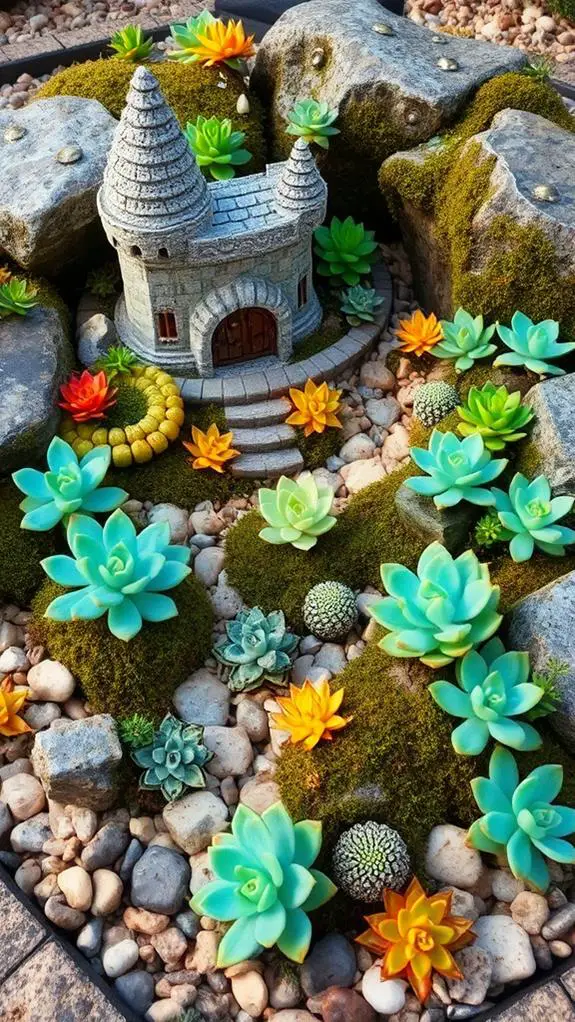
Take your succulent rock garden to the next level by crafting a themed design that tells a story or evokes a specific mood.
You can create a Desert Oasis by combining succulents with warm-toned rocks and sandy mulch, evoking the feeling of a tranquil desert escape.
For a Whimsy Wonderland, incorporate playful elements like miniature furniture, moss, and colorful succulents to create a fantastical atmosphere.
Consider the style of your home and the surrounding landscape when choosing a theme. Select succulents that fit your theme, and arrange them in a way that creates visual interest.
Don't be afraid to experiment and have fun with the design process. With a little creativity, your themed succulent garden will become a unique focal point in your front yard.
Adding Pathways and Walkways

Through meandering pathways and strategically placed walkways, you can create a sense of adventure and exploration in your succulent rock garden.
By incorporating stepping stones and gravel, you'll invite visitors to wander and discover hidden gems. Meandering paths can be designed to lead visitors through different zones of your garden, highlighting specific succulent species or textures.
Consider using natural stone or wood materials to create a cohesive look. As you plan your pathways, think about the flow of traffic and how you want visitors to experience your garden.
Incorporating Lighting and Shadows
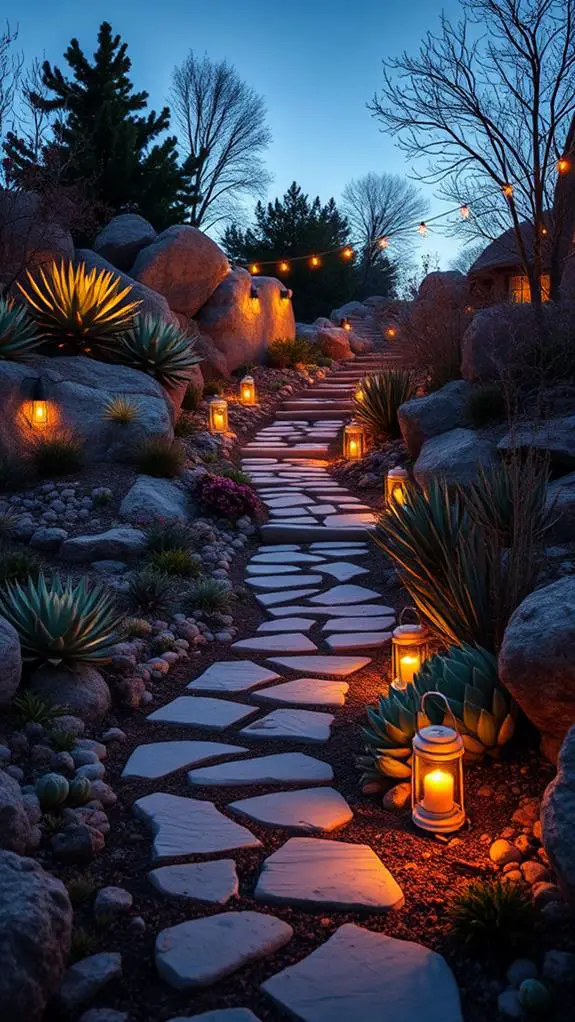
You step into your succulent rock garden at dusk, and suddenly, the entire atmosphere transforms.
The soft, warm glow of sunset shadows highlights the unique shapes and textures of your succulents, creating an otherworldly ambiance.
As night falls, moonlight effects take center stage, casting an ethereal luminescence on the garden.
Strategically placed pathway lights or spotlights can accentuate the dramatic shadows, creating an immersive experience.
Consider installing solar-powered lights to minimize energy consumption and environmental impact.
Mixing Succulents With Other Plants
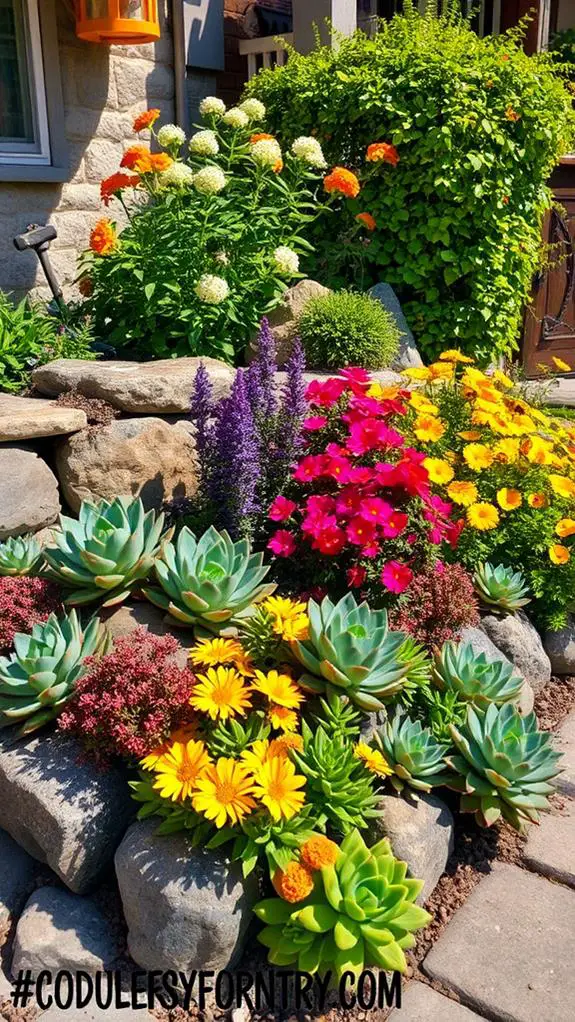
As the seasons unfold, your succulent rock garden's visual interest can be amplified by introducing complementary plants that harmonize with your succulents' unique characteristics.
You can create succulent harmony by pairing plants with similar growth habits, textures, and colors. For instance, combine sprawling succulents like Sedum with low-growing, delicate flowers like Dymondia.
Alternatively, use plant contrast to add visual appeal by mixing succulents with plants that have opposite characteristics, such as soft, fuzzy leaves with prickly cacti.
When mixing plants, consider their watering and sunlight requirements to certify a thriving garden. By thoughtfully selecting companion plants, you'll create a dynamic, visually appealing succulent rock garden that evolves with the seasons.
Maintaining a Healthy Succulent Garden

By carefully selecting companion plants, you've set the stage for a thriving succulent rock garden.
Now, it's time to maintain it. Establish a water schedule to avoid overwatering, which can lead to root rot.
Water your succulents sparingly, allowing the soil to dry out completely between waterings.
Monitor your plants for signs of pests, such as mealybugs, spider mites, or aphids.
Implement pest control measures, like neem oil or insecticidal soap, at the first sign of infestation.
Regularly inspect your plants, removing any dead or damaged leaves to prevent the spread of disease.
With proper care, your succulent rock garden will flourish, providing a stunning display of texture and color in your front yard.
FAQs
Can I Use Succulents in Shady Areas of My Front Yard?
You can grow succulents in shady areas, but be selective; most succulents need at least partial shade, and some, like Aloe and Echeveria, thrive in low-light conditions, so choose wisely and don't be afraid to experiment with shady succulent varieties.
How Often Should I Water My Succulent Rock Garden?
You'll need to establish a water schedule based on soil moisture levels, checking every 3-5 days in spring/summer and every 7-10 days in fall/winter, adjusting frequency according to your region's climate and your succulents' specific needs.
Will Succulents Attract Pests or Unwanted Wildlife?
As you cultivate your succulents, you'll likely attract pests and wildlife; however, you're not defenseless – employ pest control methods like neem oil and introduce wildlife deterrents, such as copper tape or motion-activated sprinklers, to safeguard your thriving oasis.
Can I Create a Succulent Rock Garden on a Slope?
When creating a garden on a slope, you'll need to prioritize slope stabilization and drainage management to prevent erosion and waterlogged soil. Use a mix of compacted gravel and soil, and install a retaining wall or terracing to guarantee a stable, thriving succulent rock garden.
Are Succulent Rock Gardens Suitable for High-Traffic Areas?
When designing for high-traffic areas, you'll need to ponder the foot traffic impact on your succulent rock garden. Create pedestrian pathways using compacted gravel or decomposed granite to minimize soil compaction and guarantee your plants thrive.
Conclusion
You've crafted a stunning succulent rock garden that showcases your creativity and attention to detail. Now, sit back and enjoy the oohs and aahs from passersby as your low-maintenance masterpiece thrives. Remember to monitor soil moisture, prune judiciously, and fertilize sparingly to keep your succulents happy and healthy. With regular care, your front yard will remain a vibrant, Instagram-worthy destination that invites exploration and admiration.


